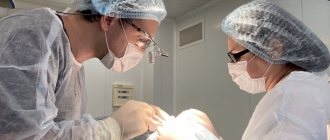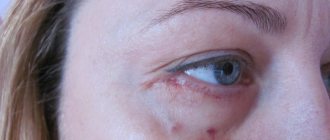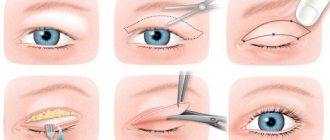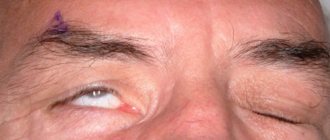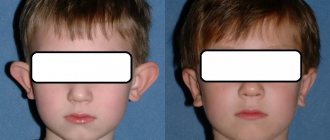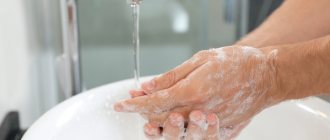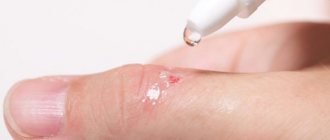Blepharoplasty is an operation aimed at eliminating age-related changes in the upper and lower eyelids or their congenital anomalies. With blepharoplasty, you can remove the overhang of the upper eyelid, swelling and bags under the eyes, correct asymmetry, make the eyes larger and change their shape. As a result, the look becomes more open, lighter, and the face is visually rejuvenated. Blepharoplasty is a fairly common procedure, it is low-traumatic and has a minimal risk of complications.
Rehabilitation after blepharoplasty
The operation is most often performed under local anesthesia. Additionally, the patient may undergo intravenous sedation; he will be in a sleepy state without feeling anxiety or fear. The procedure lasts 1-2 hours. After the patient comes to his senses, he is under the supervision of a doctor for some time. Depending on the clinic’s policy, the scope of the intervention, and the course of the postoperative period, you can go home a few hours after the procedure or spend the first day in the hospital.
Feelings after surgery
After blepharoplasty, the patient may experience the following symptoms:
- swelling, feeling of heaviness of the eyelids;
- pain in the intervention area;
- hematomas (usually under the lower eyelids);
- dry eyes or, on the contrary, lacrimation;
- diplopia (double vision), blurred vision.
Not all the symptoms from the list will necessarily be present; the appearance of some of them depends on the type of blepharoplasty, the patient’s skin type (swelling is more pronounced on oily skin than on dry skin), lifestyle, diet, compliance with all preoperative doctor’s recommendations and other factors. All these phenomena are reversible and disappear without a trace within a few days or by the end of the recovery period.
What can affect the rehabilitation period?
These conditions extend the rehabilitation period:
- passion for tobacco and alcohol;
- age from 45 years - tissues heal more slowly due to the physiological process - aging;
- genetically determined thick skin - in this case, the tissues heal more slowly.
In patients with oily skin, wounds heal faster, while in those with dry skin, the recovery time is delayed. Closely located vessels can affect the rehabilitation period.
The duration of recovery is influenced by the patient’s care of the operated area and compliance with recommendations. If a woman visits a solarium or sauna contrary to doctor’s orders, the period is significantly delayed. And improper care and touching the operated eyes with dirty hands leads to the development of infection, that is, rehabilitation is prolonged.
Rehabilitation period by day
1 day. The patient is discharged from the clinic after the operation. On this day, the eyes are most sensitive to light, so it is recommended to have dark glasses with you to put on before going outside. By evening, swelling increases. Possible lacrimation, dry eyes, blurred vision.
To reduce pain, your doctor may prescribe analgesics. Any medications (drops, ointments) should be used only as prescribed by a doctor. It is necessary to remain calm and avoid any strain on the eyes. You need to sleep on your back, with your head elevated, to improve the flow of fluid from the upper body and reduce swelling.
2-3 days. Painful sensations decrease, swelling, on the contrary, increases, reaching a maximum on the 3rd day. It is acceptable to use a cold compress on the eyes - apply an ice pack wrapped in several layers of clean, dry cloth to the operated area. There may be numbness and impaired sensitivity of the skin in the surgical area.
These days you can already wash your face and hair, trying not to wet the skin of your eyelids. As before, you should try not to strain your eyesight, devote a minimum of time to reading, watching TV, and working at the computer. The patient must continue to follow all the doctor’s prescriptions - drops, treatment of sutures if necessary.
3-5 days. Symptoms persist or improve slightly.
5-7 day . Usually on the 5th day a follow-up examination is scheduled in the clinic, the surgeon removes the sutures (if self-absorbable threads were not used). There may be redness and slight swelling in the area of the sutures.
7-10 days. Symptoms gradually decrease, and by day 10 the patient can return to normal life with some restrictions on eye strain. After 10-14 days you can wear contact lenses.
The final result of the operation can be assessed after 1-2 months. By this time, the epidermis of the skin of the eyelids is renewed, the seams become unnoticeable. After six months, postoperative scars are almost impossible to detect; they look like a thin strip in the crease of the upper eyelid or along the lower edge of the eyelashes.
Nuances of recovery for various types of blepharoplasty
After upper eyelid blepharoplasty, the recovery period is the fastest. Hematomas occur very rarely. Pain and swelling go away faster than with circumferential blepharoplasty and lower eyelid surgery.
Circumferential blepharoplasty and lower eyelid surgery require a slightly longer rehabilitation period, usually lasting up to 2-3 weeks. Swelling and pain are more pronounced, and bruises under the eyes may be present.
Transconjunctival blepharoplasty is performed through an incision on the inside of the eyelid. It is used only for the correction of lower eyelid defects. The least painful method with a quick recovery period, after which there are no scars.
Eyelid skin care after blepharoplasty
In the first days after surgery, an antiseptic patch is applied to the stitches. After 2-3 days it is removed. Sutures should be treated with any solutions only on the recommendation of the surgeon; this is not always required. As a rule, sutures are removed 5-7 days after surgery.
No special eyelid skin care is required after blepharoplasty. You need to follow normal hygiene rules, try not to cry or rub your eyes. You can use your usual cosmetics after the stitches are removed and the scars are completely healed. To quickly resolve scars, the doctor may recommend a special gel, but it is not recommended to use it without a prescription.
Answers to basic questions
When are the stitches removed?
On the first day, the woman/man is under the supervision of nurses and a doctor for 1–3 hours. The sutures are removed after 4–7 days. It all depends on the depth of the cut.
Will scars be visible on the eyelids?
Sutures are placed as close to the eyelash line as possible. After lower blepharoplasty they are almost invisible. After the end of the recovery period, they completely resolve.
After upper eyelid surgery, the sutures are more noticeable. They won't disappear in a month. It should take 12 weeks for the color to completely smooth out and even out. If scars remain after 3 months, physical therapy is performed to remove them.
When can you wear makeup after blepharoplasty?
Cosmetics can be applied 14 days after surgery. To avoid allergic reactions, since the skin is very sensitive during this period, select hypoallergenic cosmetics. Choose products from reliable brands recommended by your doctor.
Cosmetics should be light and soft. It is strictly forbidden to apply to the crust covering the surface of the wound, or to areas of irritation.
How long does it take to fully recover after blepharoplasty?
Takes 10–12 weeks. Photos of rehabilitation by day with explanations below.
A person can go home on the first day after the procedure. Severe swelling appears above and below the eyes, which can spread to the nose and area around the eyes.
2–3 days after the cosmetic procedure the swelling is slightly less. Take antiseptic drops and perform eye exercises.
A preventive examination is carried out on days 4–5. Contact lenses can be used.
On day 5, hematomas and swelling begin to subside. The skin under the patches itches. But you shouldn’t touch your eyes with your hands, much less scratch them.
6-7 days - the sutures are removed. The eye swells a little. The cyanosis disappears. Some sutures are self-dissolving, you need to come to an appointment.
On the 10th day, hemorrhages resolve. It is allowed to use cosmetics if the stitches dissolve.
After 2 weeks, the effect of the operation is almost invisible. The stitches are coming through.
40–45 days - recovery comes to an end. The effect of surgery remains noticeable.
By the end of 3 months, the sutures are completely dissolved.
What are the restrictions after blepharoplasty?
Blepharoplasty is a type of plastic surgery to correct cosmetic imperfections. 90% of success depends on the correct behavior of patients, so the following restrictions should be adhered to:
- sleep in a reclining position to prevent swelling;
- do not lift heavy objects or do bended work;
- eat as usual, avoid alcohol, smoking and spicy foods;
- do not wet the seams too much;
- do not remove the adhesive bandages yourself and do not pull out the threads;
- drink less fluid;
- give up contact optics for several months;
- do not visit the solarium, sauna and steam room;
- limit the consumption of coffee and tea;
- Do not use medications without prior consultation.
How long will the effect of blepharoplasty last?
Surgery of the upper and lower eyelids is characterized by good and lasting results. The duration of the effect depends on lifestyle.
Plastic surgeons claim that the result lasts up to 10 years, but practice shows that the effect lasts up to 5 years.
How long after you can have repeat blepharoplasty?
Repeated surgery is permitted if there are contraindications. Plastic surgeons do not recommend doing blepharoplasty more than 3 times in a lifetime.
Repeated surgery is performed after 3–4 months, when the initial sutures have completely healed.
Recommendations to speed up rehabilitation
To quickly recover after blepharoplasty and achieve optimal surgical results, additional procedures are indicated:
- Massage of the skin around the eyes and eye gymnastics. They help improve blood circulation in the intervention area and strengthen the orbicularis oculi muscle. The surgeon who performed the operation will tell you when you can start these procedures, advise the correct massage technique, and show you exercises for the eyes.
- Physiotherapy. Microcurrent therapy is most often used, which normalizes lymph flow, eliminates swelling, and accelerates skin healing. Also shown are UHF and phonophoresis.
- Maintaining sufficient skin hydration. Cosmetic products should be used after scars have healed.
What drugs should I use?
During rehabilitation after laser or classical blepharoplasty, the doctor prescribes medications for external use that stimulate the resorption of bruises and the reduction of swelling. Some ointments or creams may be prescribed to relieve itching and speed up tissue regeneration. It is important to remember that you cannot prescribe medications for yourself, since the wrong prescription can ruin the result of the correction.
In addition to medications, physiotherapy may be indicated - microcurrents, darsonval and others. These treatments also stimulate faster tissue repair in the damaged area. But before you sign up for a particular procedure, you should definitely discuss it with your surgeon.
To speed up tissue healing, special ointments are used.
In rare cases, antibiotics and other antibacterial medications may be prescribed to minimize the risk of infection. Analgesics are also sometimes prescribed if the patient complains of acute pain.
Restrictions after surgery
Most prohibitions are temporary and must be adhered to until the end of the rehabilitation period (from 1-2 weeks to 1-2 months).
After blepharoplasty you cannot:
- expose your eyes to bright light and sunlight;
- allow excessive visual strain;
- experience physical activity, including active sports;
- lift weights;
- visit the bathhouse, sauna, solarium;
- rub your eyes;
- wear contact lenses;
- sleep face down or without a pillow;
- apply decorative cosmetics;
- try to remove stitches and healing crusts yourself;
- eat spicy, salty foods, smoked foods;
- smoking and drinking alcohol.
Subsequently, it is necessary to constantly apply a cream with a high sun protection factor to the skin around the eyes. Minimally invasive cosmetic procedures (Botox, mesotherapy) are allowed 2-3 months after surgery.
Patient #2
Women fight for youth and attractiveness all their lives. But after 40 years, beauty is difficult to maintain. Surgery to remove sagging eyelids is the best thing that humanity has come up with.
Immediately after the procedure I looked scary. My biggest fear is how to go out into the street like this. There was no pain, I immediately took painkillers. Eyes are puffy and red.
On the second day I felt better. My eyelids were very swollen, I slept with my head held high. Bags under the eyes.
I must have found a qualified doctor, because on the 3rd day the swelling under the eyes began to subside. Everything around me hurt a little. The doctor recommended a light massage, but not self-massage. Go to him every day.
Fourth day - the stitches were removed. The swelling is less, but everything is itchy and itchy. Continue to drip antibiotics, do not touch them with your hands.
After 2 weeks it’s not scary to look in the mirror. The bags under my eyes are almost gone. There is some swelling left on the upper eyelid.
After another 3 days, the skin became better. You can see how it is restored and becomes elastic.
4 months after circumferential blepharoplasty there is no discomfort. When going outside, only wear glasses, because the scars are not completely gone, if the skin around is tanned, they are white.
The struggle for beauty is worth the pain. Surgery is the only way out. The recovery is long, but after rehabilitation there is no need for makeup. The eyes are open.
Author's rating
Author of the article
Alexandrova O.M.
Articles written
2100
about the author
Was the article helpful?
Rate the material on a five-point scale!
( 5 ratings, average: 4.20 out of 5)
If you have any questions or want to share your opinion or experience, write a comment below.
Possible complications
Blepharoplasty is known as an intervention with a minimal percentage of complications. However, some unpleasant consequences are still possible. Among them:
- hemorrhage in the sclera of the eye;
- hyperreaction to light;
- severe and prolonged lacrimation;
- inflammatory processes in the suture area;
- inflammation of the conjunctiva
- eversion of the century.
Sometimes these phenomena go away on their own; in some cases, medication is required. If, a few days after the operation, cutting pain, redness of the conjunctiva, an increase in previously minor symptoms, hyperemia or suppuration of the sutures, or an increase in body temperature appear, you should urgently contact the clinic where the intervention was performed.
Choosing a clinic and doctor with a good reputation, positive reviews, as well as following all the doctor’s recommendations in the pre- and postoperative period will help minimize the risk of complications.
